For those interested in crops and mechanisation, apart from the biennial Teagasc and Irish Farmers Journal Crops and mechanisation event at Oak Park, (June 2025), most would consider the UK Cereals event the most important date on the calendar.
Travelling a little further, the French Les Culturales event held south of Paris has a mix of good independent research with commercial exhibits too and is worth a visit. Another option is the DLG field day event held near Dusseldorf in Germany, which we recently attended.
Visitors had the opportunity to see everything from top class machinery demonstrations, independent testing / research/ advice as well as viewing commercial stands (primarily crop breeders) of which there was a strong presence.
Machinery demos
The strength of the machinery demos is not surprising as the DLG carries out independent machine testing and organise huge machinery events like Agritechnica. At this year’s field days in June, there were four main demos:
Mechanical weeding: An array of mechanical weeding machines were worked in row crops like maize where most had automatic guidance systems. Cereal crop weeders, mainly with variable pressure tine systems, but some spider wheel type, were also shown. Stubble cultivation and drilling: A wide range of machines with a focus on shallow stubble cultivation were demonstrated.Arena demonstrations: Big screens and commentary featured displays of high tech machines in three categories.– Sprayers, with an emphasis on their suspension system and spot-spraying capacity (green on brown).
– Fertiliser spreader spreading evenness and border spreading capacity.
– Telescopic wheel loaders (Artic and 4WS side boom models) were compared to tractor loaders on a materials handling circuit.
Robotics section: A collection of commercially available autonomous units, all working side by side, from small weeders to full size 170 kW (200hp + ), units, were on view in this area.Below are 10 of the more impressive machines we saw in action, ranging from fertiliser spreaders, mechanical weeders to autonomous tractors.
1. The Krone and Lemken joint venture, the ‘Combined Powers’ project, is a full-size 170 kW autonomous tractor unit designed as a testbed to develop implement control systems that will work reliably without human supervision. This latest iteration, was quite impressive to see in the field working a full scale cultivator.

The Combined Powers autonomous tractor is a testbed to develop implement control systems that will work reliably without human supervision.
2. The AgXeed AgBot 5.115T2 is a commercially available 115 kW (150hp) autonomous vehicle with front and rear linkage, full pto and hydraulics, and a diesel-electric drive powering its track drive system. While weight (almost 8t) and current price may seem excessive today, this completely clean-slate approach to a self-driving
ag machine is very impressive working in the field with a 3m Amazone tined cultivator.
The AgXeed AgBot 5.115T2 demonstrated using a 3m Amazone tine cultivator,
3. The ARA high precision spot spraying unit is commercially available and uses a hooded design to allow high intensity lighting and cameras to capture high quality images that allow the unit pick out and spray individual weeds in row crops. It has a spray nozzle spacing of just 4cm allowing spray areas of just 6cm x 6cm to be targeted at 7kmh speed. A 6m unit was shown on the smaller ‘wheeled’
AgXeed Agbot 2.055W4 model and it can cover up to 90ha in a 24hr period. 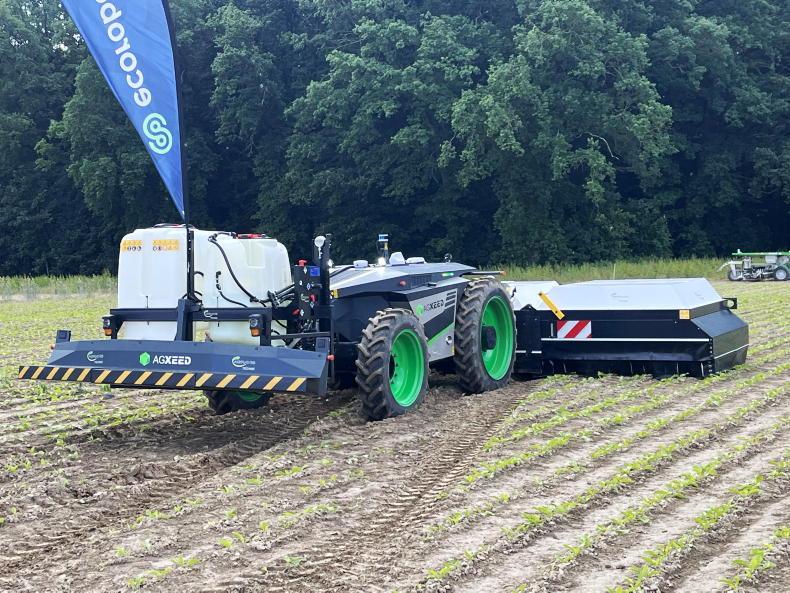
The ARA spot-spraying unit uses cameras underneath a hooded canopy and allows individual spray areas as small as 6cm x 6cm.
4. An Amazone ZA-TS spreader was, unusually, mounted on a Claas Axion Terra Trac for a basic spread pattern check (just six trays) live in the demo ring. Results were highlighted on a big screen display. Border spreading was also checked.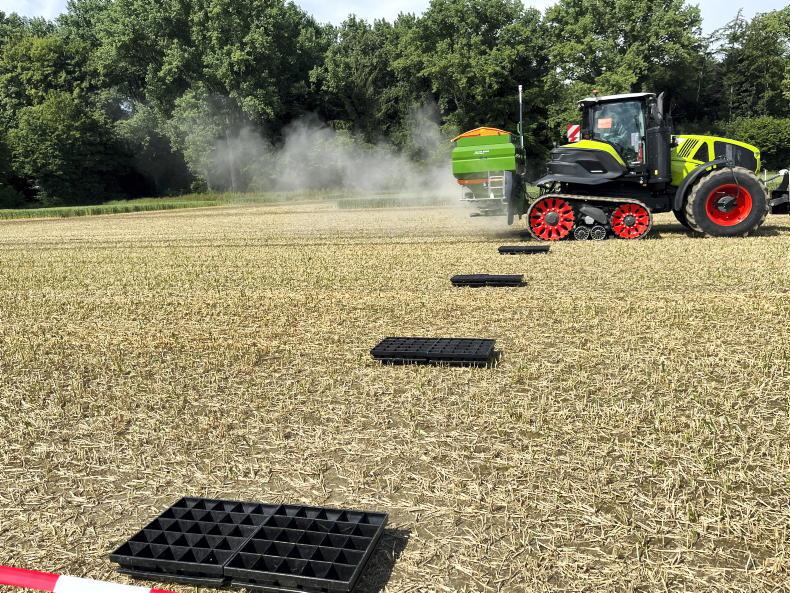
Amazone's ZA-TS spreader was demonstrated on a Claas Axion Terra Trac tractor.
5. The French-built Novag T-Force Plus direct drill was put through its paces in 4m format. These drills have a single notched disc opener coupled with a knife coulter that creates an inverted T-shaped slot – a concept used by other manufacturers also. A double press system is used to firm the soil. These are heavy (7.5t empty) and quite expensive drills with a relative high power requirement of up to 50hp per meter sowing width.
6. The CropZone electrical weeder /
desiccator uses high voltage electrical power to kill foliage. The PTO-driven generator can produce up to 112kW for a 12m boom. The system works at between 1,600 and 5,000 volts not unlike electric fence voltage, but delivered continuously to transmit huge electrical energy. Power is delivered through a boom with an array of crop contact tine types to suit the specific application; the crop contact sections are hanging down in the photo - they would be horizontal in work.
One interesting application of this technology is in potatoes to burn down potato haulm in advance of harvesting; a significant problem since diquat cannot be used. Co Meath based John Deere dealers, Meath Farm Machinery are agents so use on potatoes and high value crops may soon be tested in our conditions. 
The CropZone electrical weeder uses a pto generator to produce between 1,600 and 5,000 volts to instantly kill weeds.
7. Trailed sprayers were demonstrated on a bumpy track with the boom suspended over a wheat crop, making it easy to assess boom stability in a range of conditions. The sprayers also demonstrated their ability to spot spray by spraying green areas in a sprayed-off stubble.
8. Pneumatic fertiliser spreaders seem to be making a comeback. A Horsch Leeb Xeric was displayed with a 14m3 tank, a 36m boom with outlets every 1.5m, and twin steering axles with IF 650/85R42 tyres. Rauch also displayed a mounted Aero pneumatic spreader with a 24m boom. These spreaders overcome some of the challenges with wide bout broadcast spreaders, while offering the potential for variable rate application working on small areas of fields.
This Horsch Leeb Xeric with a 14m3 tank and 36m boom has outlets every 1.5m.
9. The Zurn Australian built Seed Terminator fits to the back of a combine and destroys weed seeds in the chaff exiting the combine. The hammer mills can destroy up to 98% of weed seeds requiring up to 70kW additional power from the combine’s drive system.
While this will reduce the weed burden, 2% of remaining seeds plus those that come out with the straw would still present a challenge for weeds like black grass or Italian ryegrass.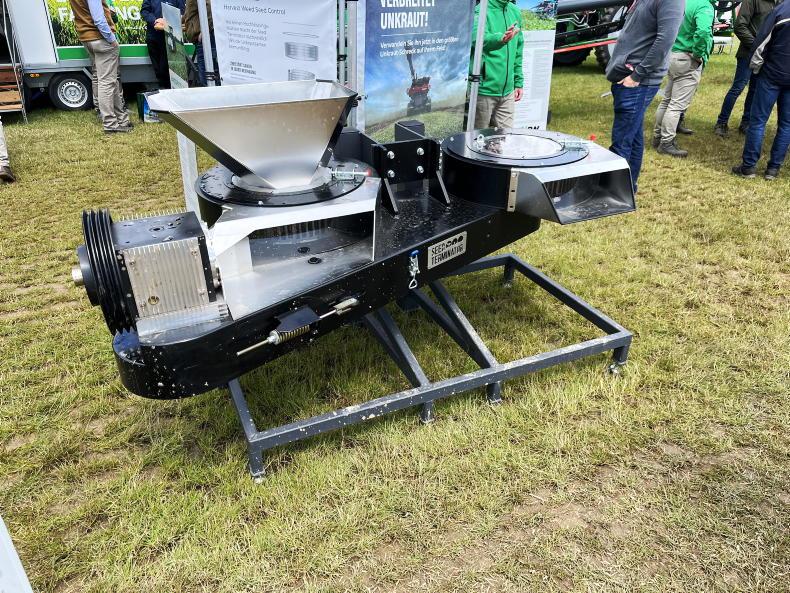
The Zurn seed terminator is designed to be mounted on the back of a combine to destroy weed seeds.
10.
The tractors in the materials handling demo were partly ‘out-manoeuvred’ by the tighter-turning artic and four-wheel steer loaders with drone views showing their turning circles on screen. However, the tractors put in a very good performance otherwise, with their high spec loaders allowing quick turnaround times at all tasks.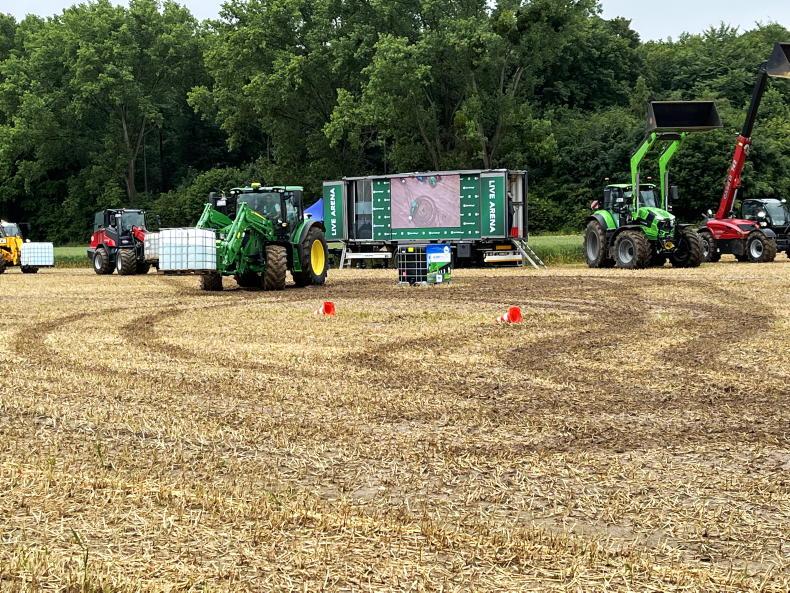
Loader tractors as well as articulated wheel loaders and side boom telehandlers were also demonstrated.
For those interested in crops and mechanisation, apart from the biennial Teagasc and Irish Farmers Journal Crops and mechanisation event at Oak Park, (June 2025), most would consider the UK Cereals event the most important date on the calendar.
Travelling a little further, the French Les Culturales event held south of Paris has a mix of good independent research with commercial exhibits too and is worth a visit. Another option is the DLG field day event held near Dusseldorf in Germany, which we recently attended.
Visitors had the opportunity to see everything from top class machinery demonstrations, independent testing / research/ advice as well as viewing commercial stands (primarily crop breeders) of which there was a strong presence.
Machinery demos
The strength of the machinery demos is not surprising as the DLG carries out independent machine testing and organise huge machinery events like Agritechnica. At this year’s field days in June, there were four main demos:
Mechanical weeding: An array of mechanical weeding machines were worked in row crops like maize where most had automatic guidance systems. Cereal crop weeders, mainly with variable pressure tine systems, but some spider wheel type, were also shown. Stubble cultivation and drilling: A wide range of machines with a focus on shallow stubble cultivation were demonstrated.Arena demonstrations: Big screens and commentary featured displays of high tech machines in three categories.– Sprayers, with an emphasis on their suspension system and spot-spraying capacity (green on brown).
– Fertiliser spreader spreading evenness and border spreading capacity.
– Telescopic wheel loaders (Artic and 4WS side boom models) were compared to tractor loaders on a materials handling circuit.
Robotics section: A collection of commercially available autonomous units, all working side by side, from small weeders to full size 170 kW (200hp + ), units, were on view in this area.Below are 10 of the more impressive machines we saw in action, ranging from fertiliser spreaders, mechanical weeders to autonomous tractors.
1. The Krone and Lemken joint venture, the ‘Combined Powers’ project, is a full-size 170 kW autonomous tractor unit designed as a testbed to develop implement control systems that will work reliably without human supervision. This latest iteration, was quite impressive to see in the field working a full scale cultivator.

The Combined Powers autonomous tractor is a testbed to develop implement control systems that will work reliably without human supervision.
2. The AgXeed AgBot 5.115T2 is a commercially available 115 kW (150hp) autonomous vehicle with front and rear linkage, full pto and hydraulics, and a diesel-electric drive powering its track drive system. While weight (almost 8t) and current price may seem excessive today, this completely clean-slate approach to a self-driving
ag machine is very impressive working in the field with a 3m Amazone tined cultivator.
The AgXeed AgBot 5.115T2 demonstrated using a 3m Amazone tine cultivator,
3. The ARA high precision spot spraying unit is commercially available and uses a hooded design to allow high intensity lighting and cameras to capture high quality images that allow the unit pick out and spray individual weeds in row crops. It has a spray nozzle spacing of just 4cm allowing spray areas of just 6cm x 6cm to be targeted at 7kmh speed. A 6m unit was shown on the smaller ‘wheeled’
AgXeed Agbot 2.055W4 model and it can cover up to 90ha in a 24hr period. 
The ARA spot-spraying unit uses cameras underneath a hooded canopy and allows individual spray areas as small as 6cm x 6cm.
4. An Amazone ZA-TS spreader was, unusually, mounted on a Claas Axion Terra Trac for a basic spread pattern check (just six trays) live in the demo ring. Results were highlighted on a big screen display. Border spreading was also checked.
Amazone's ZA-TS spreader was demonstrated on a Claas Axion Terra Trac tractor.
5. The French-built Novag T-Force Plus direct drill was put through its paces in 4m format. These drills have a single notched disc opener coupled with a knife coulter that creates an inverted T-shaped slot – a concept used by other manufacturers also. A double press system is used to firm the soil. These are heavy (7.5t empty) and quite expensive drills with a relative high power requirement of up to 50hp per meter sowing width.
6. The CropZone electrical weeder /
desiccator uses high voltage electrical power to kill foliage. The PTO-driven generator can produce up to 112kW for a 12m boom. The system works at between 1,600 and 5,000 volts not unlike electric fence voltage, but delivered continuously to transmit huge electrical energy. Power is delivered through a boom with an array of crop contact tine types to suit the specific application; the crop contact sections are hanging down in the photo - they would be horizontal in work.
One interesting application of this technology is in potatoes to burn down potato haulm in advance of harvesting; a significant problem since diquat cannot be used. Co Meath based John Deere dealers, Meath Farm Machinery are agents so use on potatoes and high value crops may soon be tested in our conditions. 
The CropZone electrical weeder uses a pto generator to produce between 1,600 and 5,000 volts to instantly kill weeds.
7. Trailed sprayers were demonstrated on a bumpy track with the boom suspended over a wheat crop, making it easy to assess boom stability in a range of conditions. The sprayers also demonstrated their ability to spot spray by spraying green areas in a sprayed-off stubble.
8. Pneumatic fertiliser spreaders seem to be making a comeback. A Horsch Leeb Xeric was displayed with a 14m3 tank, a 36m boom with outlets every 1.5m, and twin steering axles with IF 650/85R42 tyres. Rauch also displayed a mounted Aero pneumatic spreader with a 24m boom. These spreaders overcome some of the challenges with wide bout broadcast spreaders, while offering the potential for variable rate application working on small areas of fields.
This Horsch Leeb Xeric with a 14m3 tank and 36m boom has outlets every 1.5m.
9. The Zurn Australian built Seed Terminator fits to the back of a combine and destroys weed seeds in the chaff exiting the combine. The hammer mills can destroy up to 98% of weed seeds requiring up to 70kW additional power from the combine’s drive system.
While this will reduce the weed burden, 2% of remaining seeds plus those that come out with the straw would still present a challenge for weeds like black grass or Italian ryegrass.
The Zurn seed terminator is designed to be mounted on the back of a combine to destroy weed seeds.
10.
The tractors in the materials handling demo were partly ‘out-manoeuvred’ by the tighter-turning artic and four-wheel steer loaders with drone views showing their turning circles on screen. However, the tractors put in a very good performance otherwise, with their high spec loaders allowing quick turnaround times at all tasks.
Loader tractors as well as articulated wheel loaders and side boom telehandlers were also demonstrated.















 This is a subscriber-only article
This is a subscriber-only article






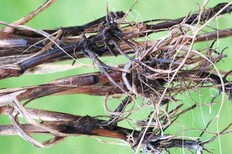


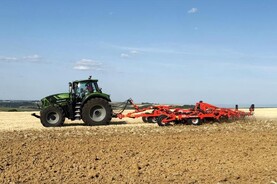

SHARING OPTIONS: